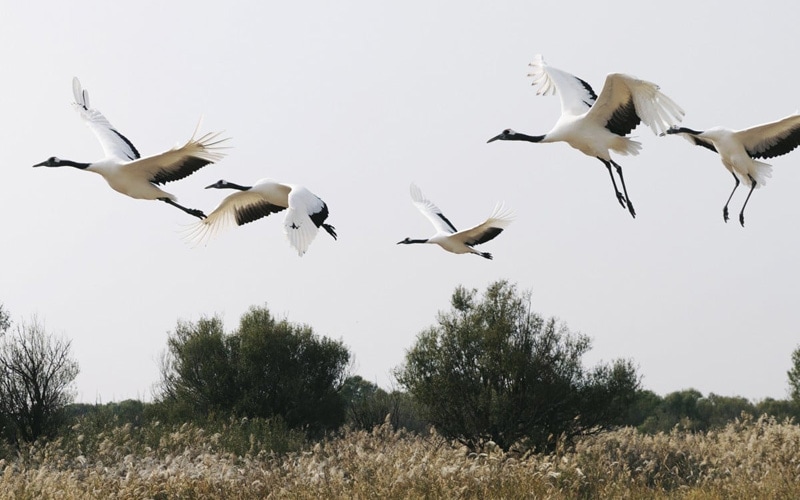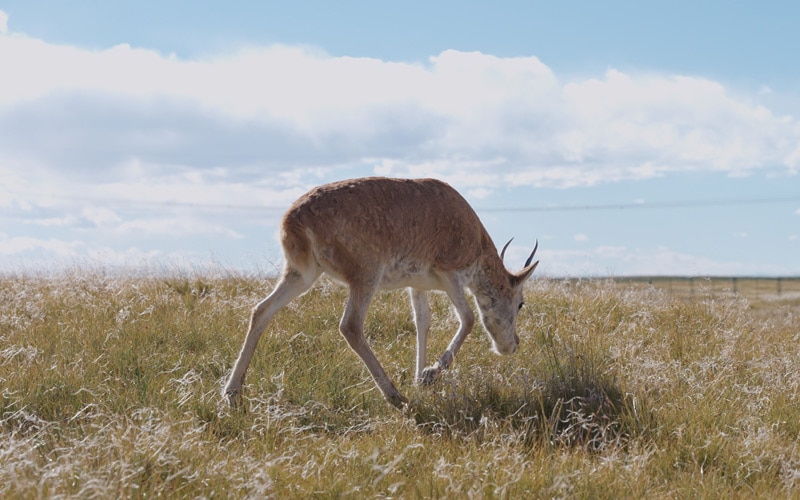Guarding without Interfering: The Story of China's Oriental Stork
As a national-level protected animal, the Oriental stork (Ciconia boyciana) is classified as endangered on the International Union for Conservation of Nature (IUCN) Red List of Threatened Species. With a population in decline due to habitat loss and the degradation of its wintering areas, stopovers, and breeding sites, the remaining population of these distinctive white birds totals just 10,000 across East Asia.
At the northern end of the Bohai Bay in China's Shandong Province, however, the world's first international wetland city has created a new habitat paradise for this endangered species.
An international transit hub for birds
The Yellow River has the highest sediment of all rivers worldwide, which has in turn given rise to the world's youngest wetland ecosystems at the river's mouth. However, the Yellow River Delta faces severe environmental threats. To protect the wetland ecosystem, encourage the growth of biodiversity, and safeguard the rare and endangered species that inhabit the Yellow River estuary, the Yellow River Delta National Nature Reserve was set up in Shandong Province in 1992.
A unique ecosystem coupled with optimum natural conditions make the estuary a paradise for birds. Of the world's nine bird migration routes, the Yellow River estuary spans East Asia, Australasia, and the western Pacific Ocean, forming an important migratory transit station and wintering and breeding ground for migratory birds.
In total, the area accommodates 6 million birds spanning 373 species. Twenty-six of these species are designated at level one protection and another 65 at level two, which combined account for 24% of China's total protected birds. The breeding population of Oriental storks in the reserve is nearly 200 pairs, representing the largest breeding ground in China. And this is also the case for the Black-billed gull, which has a breeding population of more than 10,000 - the Yellow River Delta as one of its three breeding sites globally.
Nine Global Migratory Bird Migration Routes
Birds know best
As a large bird, this stork builds its nests on branches near treetops and thus the Yellow River Delta region is not a historical breeding ground for the species.
But since the discovery in 2003 that the Oriental stork was breeding in the reserve, its numbers have been observed to be increasing each year. As the area is far from the sea, soil salinization is high, and the area lacks tall trees, the birds chose to build their nests on electricity pylons, creating a safety hazard. For this reason, staff at the Yellow River Delta National Nature Reserve built many artificial nests adapted to their specific breeding habits, which in turn encouraged them to migrate to the reserve.
An oriental white stork and bird eggs in an artificial nest (Video credit: Yellow River Delta National Nature Reserve, Shandong Province)
If the ecology is good, the birds stay. And that is what happened in this case. Alongside the suitable natural environment and attention of the reserve's staff, technology is playing a key role in protecting the species and enabling research.
Tech as guardian
An integrated sky-to-ground monitoring network comprising, big data, IoT, remote sensing, radar, and autonomous aerial vehicles feeds back data to the protected area's monitoring center, where it is displayed on a big screen. Constructed under the Huawei TECH4ALL initiative, the solution combines existing and new data collection devices connected by a 5G network deployed by local operators. The collected data is transmitted to cloud by the network, where AI identifies the species and analyzes the data. The insights yielded have provided a series of innovative ideas and methods for boosting scientific research, monitoring, and protection.

Biodiversity Monitoring Platform (Photo credit: Shandong Yellow River Delta National Nature Reserve Monitoring Center)
As of March 2024, the monitoring platform had collected more than 54,000 videos and 89,000 images, both of which have been used to train the AI system to recognize 47 species.
-
54,000videos
used for species' identification
-
89,000 images
used to train the AI system
-
47species
identifiable by AI after recognition training
The Yellow River Delta Nature Reserve covers a vast area that attracts a large number of birds, which by their nature are hard to track. Before introducing tech-based monitoring, staff had to go deep into the protected area to observe and record what they saw. Today, they can monitor and count species in the reserve in real time on a large screen, reducing costs and time, improving efficiency, and yielding greater precision. As the platform is trained to identify more species and accumulates data, the accuracy of AI recognition improves. At present, species in flight and in groups can be identified, with the accuracy of identifying flagship species and large birds for which the AI is trained exceeds 90%.
Oriental White Stork foraging (Video Source: Yellow River Delta National Nature Reserve, Shandong Province)
This project provides an exemplary case study of protecting species intelligently without disturbing their lives or habitats.





